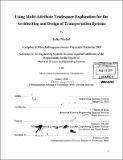Using multi-attribute tradespace exploration for the architecting and design of transportation systems
Author(s)
Nickel, Julia, S.M. Massachusetts Institute of Technology
DownloadFull printable version (25.99Mb)
Other Contributors
Massachusetts Institute of Technology. Engineering Systems Division.
Advisor
Adam M. Ross.
Terms of use
Metadata
Show full item recordAbstract
The field of Engineering Systems maintains that fundamental engineering principles exist, which apply across different domains of complex socio-technical systems. In this thesis, a state-of-the art decision and design evaluation method developed using aerospace cases, Multi-Attribute Tradespace Exploration (MATE), is applied for the first time to a transportation design problem. Through the application process across domains, differences between the aerospace and transportation domain are characterized: (1) a "mission objective" has not emerged as a welldefined, integral concept for transportation project planning in the same way it did in the military and space communities; (2) a simple stakeholder structure for the purpose of the analysis is not a reasonable assumption, (3) inheritance (legacy structures and legacy expectations) in transportation planning brings with it the stickiness of the status quo and people's attachment to things they possess; (4) several cost types exist in addition to monetary costs, e.g. harmful effects to life and spending of scarce resources (time, money); (5) decisions about the welfare of stakeholders in transportation planning are inextricably linked to technical decisions. It follows that fundamental engineering systems design principles need to be general enough to encompass these domain differences. Decisions about the welfare of stakeholders (public, future generations, environment) by a legitimized representative decision maker raise the question about the desirability of prescriptive guiding principles for decision making, in order to ensure consideration for the represented constituency when their interests need to be traded off with personal and organizational interests of the decision maker. Decision makers themselves seek such guidance to help them in trading off and justifying decisions about multiple competing goals in complex situations. One established method to provide such guidance is Cost-Benefit Analysis (CBA). CBA is a central, established, prescriptive evaluation method used in several domains, including transportation. In order to compare insights gained through the emerging method MATE and the established method CBA, two case studies, a Chicago Airport Express and a High-Speed Rail link between Portugal and Spain, are evaluated using those two methods. CBA assumes a broad view over all affected stakeholders, decision making or not, and seeks to ensure that net benefits to society outweigh net costs. MATE seeks to best meet decision makers' expectations for a system. Attributes (tangible and intangible) that are valuable to individual stakeholders, but not to society as a whole, are captured in the value-based approach in MATE. They are purposefully excluded in CBA. A challenge that the value-based approach in MATE brings about are framing issues that can arise when utility theory is applied to decision making stakeholders who have mandates to represent other stakeholders. For both aerospace and transportation domains, political vision and technical understanding of properties of different designs are important for decision making. A real feedback cycle between goal capture and low-fidelity technical modeling of different design options as suggested in MATE does not seem to exist in transportation planning. MATE seems useful as a tool to support improved communication about system expectations and technical options. Future research will need to address how value-based attribute capture can be performed in the typical complex stakeholder structure of transportation systems. Recognizing that problems of equity and value judgments are an inherent part of (some) technical decisions, the question of how to support a decision maker in expressing those attributes (even if difficult and controversial) and understanding different design concepts' impact on technical properties becomes part of the design engineer's job.
Description
Thesis (S.M.)--Massachusetts Institute of Technology, Engineering Systems Division, 2010. Cataloged from PDF version of thesis. Includes bibliographical references (p. 241-249).
Date issued
2010Department
Massachusetts Institute of Technology. Engineering Systems DivisionPublisher
Massachusetts Institute of Technology
Keywords
Engineering Systems Division.